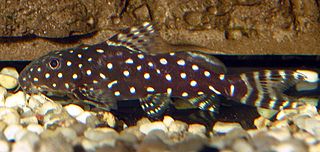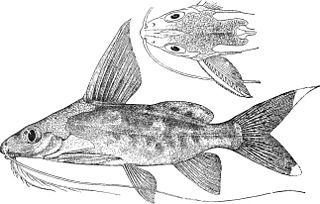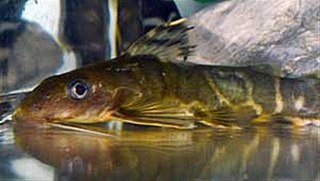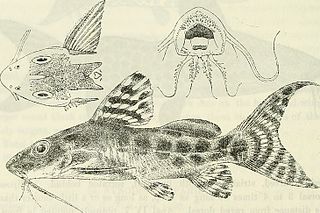
Synodontis nigrita, known as the false upside down catfish, is a species of upside-down catfish that occurs widely in northern Africa. It was first described by French zoologist Achille Valenciennes in 1840. The type specimen is in the Muséum National d' Histoire Naturelle de Paris.

Synodontis angelicus is a species of upside-down catfish commonly named polkadot squeaker, black clown catfish, whitespotted squeaker, pearl squeaker, or angel squeaker. This species is native to the Congo Basin of Cameroon, the Democratic Republic of the Congo and the Republic of the Congo. It was originally described in 1891 by Belgian ichthyologist Louise Schilthuis after its discovery in the Malebo Pool of the Congo River. The specific name "angelicus" means heavenly or divine, since juveniles of this species are remarkable for their bright coloring.

Synodontis alberti, the bigeye squeaker, Albert's syno, bigspotted squeaker, or high-fin synodontis, is a species of upside-down catfish native to the Congo Basin of Cameroon, the Democratic Republic of the Congo and the Republic of the Congo. It was originally described in 1891 by Belgian ichthyologist Louise Schilthuis after its discovery in the Malebo Pool of the Congo River.

Synodontis brichardi, known as Brichard's synodontis, is a species of upside-down catfish that is endemic to the Democratic Republic of the Congo where it occurs in the rapids of the lower Congo River. It was first described by Max Poll in 1959. The original specimens were obtained from the rapids at Kinsuka, Kinshaa, Zaire. The species name brichardi is named in honor of Pierre Brichard, an aquarium fish exporter who first discovered the fish.

Synodontis caudalis, known as the filament tailed synodontis, or the whiptail synodontis, is a species of upside-down catfish native to the Democratic Republic of the Congo. It was first described by Belgian-British zoologist George Albert Boulenger in 1899, from specimens collected in what is now the Democratic Republic of the Congo. The species name caudalis comes from the Latin word cauda, meaning tail, and refers to the elongated filaments in the caudal fin of the species.

Synodontis depauwi is a species of upside-down catfish that is endemic to the Democratic Republic of the Congo where it can be found in Stanley Pool. It was first described by British-Belgian zoologist George Albert Boulenger in 1899, from specimens collected in Stanley Pool, in the Democratic Republic of the Congo. The species name depauwi is in honour of the "conservateur des collections de l'Université libre de Bruxelles", Louis De Pauw.

Synodontis frontosus, known as the Sudan squeaker, is a species of upside-down catfish that is widely distributed throughout northern and central Africa. It has been reported in Chad, Democratic Republic of the Congo, Ethiopia, Kenya, Somalia, Sudan, and Uganda. It was first described by French zoologist Léon Vaillant in 1895, from specimens collected in the White Nile in Sudan. The species name frontosus is Latin, and means "broad head".
Synodontis iturii is a species of upside-down catfish that is endemic to the Democratic Republic of the Congo where it is only known from the Ituri River. It was first described by Franz Steindachner in 1911. The original specimens were obtained in the Ituri River, in what is now the Democratic Republic of the Congo. The species name iturii is derived from the Ituri River, where the species was discovered.

Synodontis longirostris, known as the eyespot synodontis, is a species of upside-down catfish that is native to the Democratic Republic of the Congo where it occurs in the Congo Basin. It was first described by British-Belgian zoologist George Albert Boulenger in 1902, from specimens obtained in the Ubangi River at Banzyville. The species name longirostris comes from the Latin word longus, meaning "long", and the Latin word rostrum, meaning snout, referring to the long snout on this species.

Synodontis multimaculatus, known as the dotted synodontis, is a species of upside-down catfish that is native to the Democratic Republic of the Congo where it is found in the Ubangi River. It was first described by British-Belgian zoologist George Albert Boulenger in 1902, from a specimen collected in the Ubangi River in Mobayi-Mbongo, the Democratic Republic of the Congo. The species name multimaculatus is derived from the word multi, meaning many, and the Latin word maculatus, meaning spots, referring to the many spots on the fish.

Synodontis nebulosus, known as the cloudy squeaker, or clouded squeaker, is a species of upside-down catfish that is native to the lower Zambezi River basin of Malawi, Mozambique, Zambia and Zimbabwe. It was first described by German naturalist and explorer Wilhelm Peters in 1852, from a specimen collected in the Zambezi River at Tete, Mozambique. The species name nebulosus is derived from the Latin word nebulosus, meaning "foggy", "cloudy", or "full of mist".

Synodontis nigromaculatus, known as the spotted squeaker, the blackspotted squeaker, or the speckled squeaker, is a species of upside-down catfish that is found widely in southern Africa. It has been identified in Angola, Botswana, the Democratic Republic of the Congo, Mozambique, Namibia, South Africa, Zambia, and Zimbabwe. It was first described by British-Belgian zoologist George Albert Boulenger in 1905, from specimens collected in Lake Bangweulu in Zambia.
Synodontis obesus, known as the Coas synodontis, is a species of upside-down catfish that is native to the coastal drainages of Cameroon, Ghana, Nigeria and Togo. It was first described by British-Belgian zoologist George Albert Boulenger in 1898. The species name obesus is derived from the Latin word obesus, meaning "fat".

Synodontis ornatipinnis, known as the barfin synodontis, is a species of upside-down catfish that is native to the Congo Basin of the Democratic Republic of the Congo and Zambia. It was first described by British-Belgian zoologist George Albert Boulenger in 1899, from specimens collected in Mbandaka, on the Congo River in what is now the Democratic Republic of the Congo. The species name ornatipinnis means "ornate fins".
Synodontis pardalis is a species of upside-down catfish that is endemic to Cameroon where it occurs in the Dja River drainage. It was first described by British-Belgian zoologist George Albert Boulenger in 1908, from specimens collected in the Dja River in southern Cameroon. The species name pardalis is derived from the Greek word pardalis, which means "leopard", which refers to the spotted pattern on the fish.

Synodontis serratus, known as the shield-head squeaker, is a species of upside-down catfish that is native to the Nile basin of the Democratic Republic of the Congo, Egypt, Ethiopia and Sudan. It was first described by German naturalist and explorer Eduard Rüppell in 1829, from specimens obtained near Cairo, Egypt. The species name serratus comes from the Latin word serra, meaning "saw", which refers to the serrated pectoral spines of the species.

Synodontis smiti, known as the longtail Synodontis, or Smit's Synodontis, is a species of upside-down catfish that is endemic to the Democratic Republic of the Congo where it is found in the middle and upper Congo Basin. It was first described by British-Belgian zoologist George Albert Boulenger in 1902, from specimens obtained in the Ubangi River at Banzyville. The species name smiti is named for Pierre Jacques Smit, who illustrated the plates in Boulenger's works.

Synodontis soloni, known as the scissortail synodontis, is a species of upside-down catfish that is endemic to the Democratic Republic of the Congo where it is found in the Ubangi River and the rapids just below Stanley Pool. It was first described by British-Belgian zoologist George Albert Boulenger in 1899, from the Congo River in what is now the Democratic Republic of the Congo. The species name soloni is a patronym and in memory of Alexandre Solon, who assisted with the collection of fish.
Synodontis unicolor is a species of upside-down catfish that is endemic to the Democratic Republic of the Congo where it occurs in the area of Luapula-Mweru. It was first described by George Albert Boulenger in 1915. The original specimens were obtained in Kasenga, on the Luapula River in what is now the Democratic Republic of the Congo. The species name unicolor means "one color", referring to the uniform dark-brown coloration on the body and fins.

Synodontis woosnami, known as the Upper Zambezi squeaker, or bubblebarb squeaker, is a species of upside-down catfish that is native to Angola, Botswana, Namibia, Zambia and Zimbabwe where it is found in the upper Zambezi and Okavango River basins and the Cunene River. It was first described by British-Belgian zoologist George Albert Boulenger in 1911, from a specimen collected in the Okavango River in the Lake Ngami district of Botswana. The species name woosnami is derived from R. B. Woosnam, the collector of the first specimen.
















